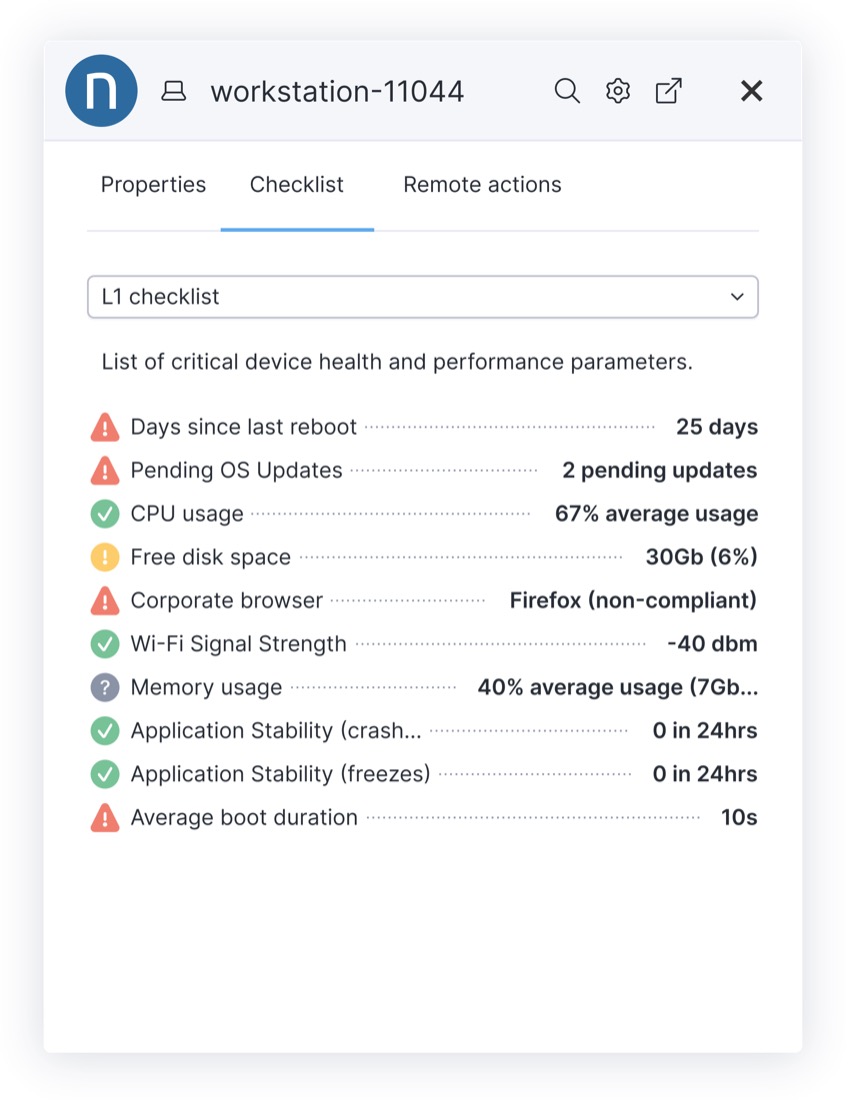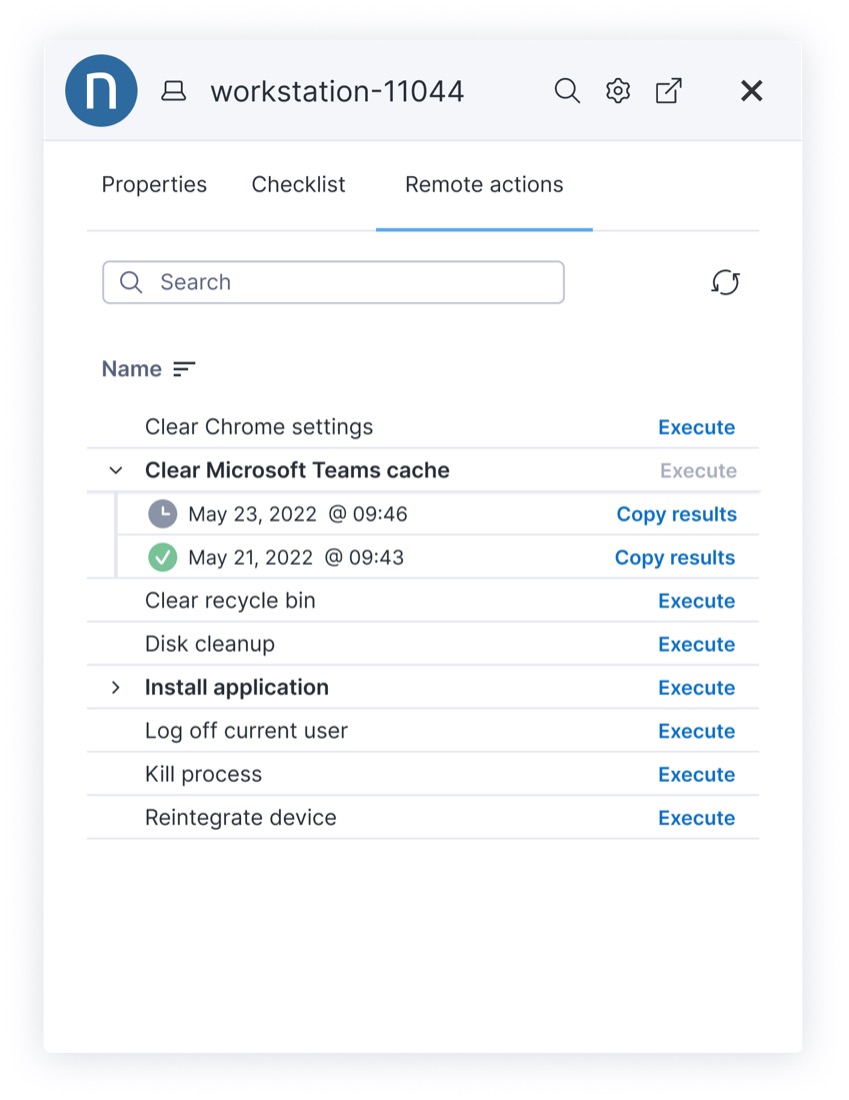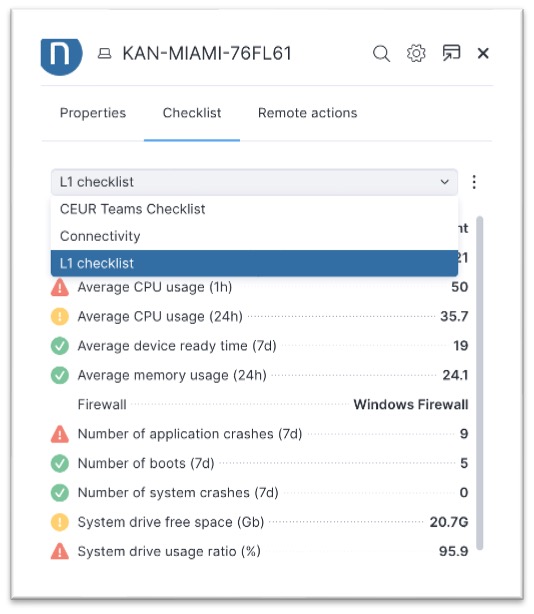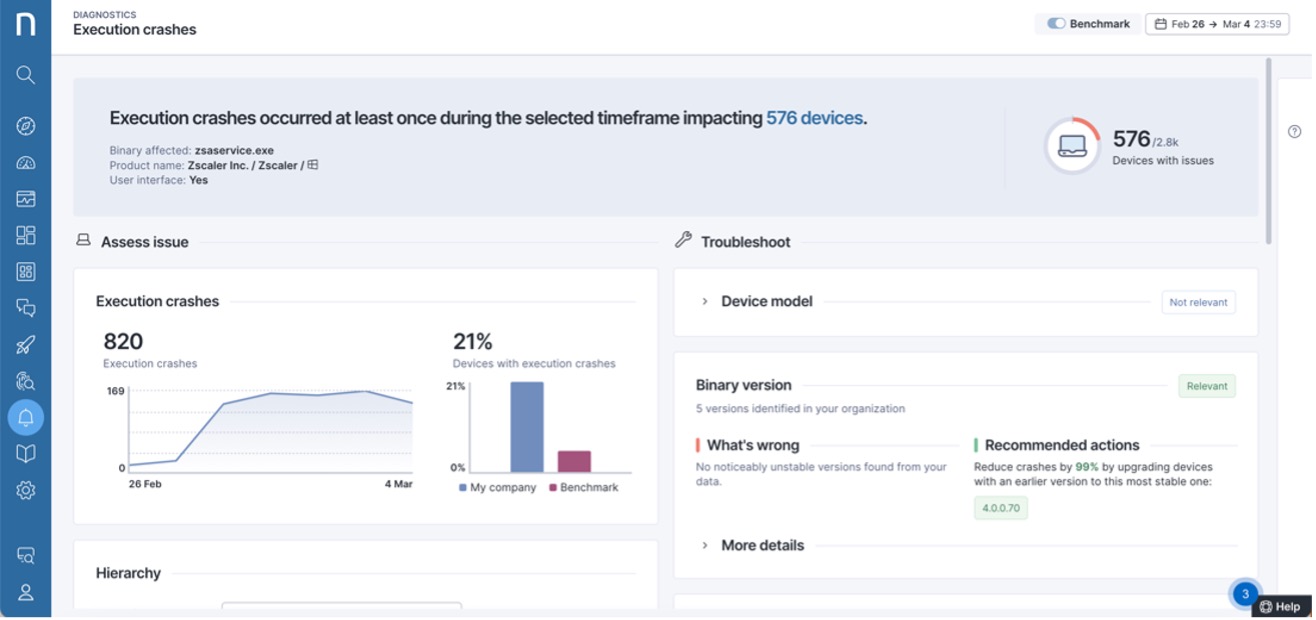What does a normal day look like for your service desk? A flood of incoming tickets. Insufficient data to quickly find the root cause of issues. And a lack of remediation power to close tickets fast. Level 1 (L1) analysts are forced to spend time jumping across tools, reaching out to end users, or relying on guesswork to solve problems.
The result: inflated average handling time (AHT) and mean time to resolution (MTTR), an increasing number of escalations to more experienced (and expensive) teams, and reduced bandwidth for higher level teams to focus on systemic and strategic projects, proactive fixes, automations, and more. All this leaves leadership wondering if its possible to improve service desk operations.
Improve Service Desk Operations with Amplify
Amplify is a platform-agnostic browser plugin that puts Nexthink’s enterprise-wide, endpoint-deep incident information, diagnostic checklists, and automated remediation power at your frontline agent’s fingertips. The result? Your staff can immediately see, diagnose, and fix issues from their service desk platform’s interface in seconds – from one view, without end user involvement.
Let’s dig into five ways that Amplify can help improve help desk operations through faster ticket resolution, less escalation, more proactivity, and ultimately operational efficiencies and cost reduction.
1. Get Upfront Information Fast
Service desk analysts spend an inordinate amount of time on tickets simply pulling together information about a user, device properties, network details, and more. Often, this requires a live interaction with an employee. It may also require cross-referencing multiple sources of information to get the full scope of data needed to begin a diagnosis. This is no way to work.
What if this information was unified, holistic, and easily accessible with a single click and with zero end user involvement?
With Amplify’s endpoint telemetry data at their fingerprints, service desk staff can see key device properties and attributes of the employee in a single view – erasing the process of gathering foundational information and shortening the time it takes to start diagnosing a problem – setting agents on the right course from the moment they open a ticket.

2. Diagnose Root Causes Easily
Diagnosing the root cause of an IT issue may be the most challenging aspect of service desk staff’s duties – and it’s often the reason why so many tickets get escalated to higher level analysts. Why? Because it’s not enough to know what happened from a user’s perspective. To effectively diagnose an issue at its core, one must have the ability to uncover the layers of symptoms to get to the root cause of issues.
Too often, tickets are raised containing an employee’s perception data, but that rarely captures the entire issue. Service desk staff often resort to limited data, guesswork, and a process of elimination to try to understand what a problem is really about and how they might go about solving it.
Now imagine your service desk team had clear indicators based on AI to intelligently guide their diagnostics. This is what Amplify delivers. Forrester’s Total Economic Impact study of Nexthink estimates a 5-10 minute reduction in call duration. Most of those time savings come from unified information upfront and quick and easy diagnostics.

3. Fix Issues Effortlessly with Remote Actions
Service desk agents fix the same problems repeatedly. It’s part of the job. Slow machines, poor connectivity, lost access to the shared drive happen every day. But these straightforward problems have time consuming solutions. And when the resolution takes too long, tickets get escalated because too many new tickets are piling up.
Amplify’s turnkey remote action capabilities improve service desk operations by enabling agents to solve issues fast. One-click remediations ranging from simple disk clean-ups to updating certificates or installing applications allow agents to push a preconfigured remote action to resolve issues swiftly – in literally one click.

4. Get More from Level 1 Staff – And Do More With Existing Resources
Level 1 analysts make up the frontlines of the service desk. They are typically junior level staff who are tasked with processing and resolving the most common and straightforward tickets that arrive at the service desk. More specialized and complex issues, in terms of their nature and difficulty to diagnose and remediate, are typically handled by higher level analysts – L2 and above. Indeed, this division of labor makes perfect sense.
But what if you could get more out of your Level 1 staff? What if Level 1 agents could process and resolve issues today that yesterday they could not? This would have a tremendous effect on the overall service desk operational performance and serve as another lever to reduce costly escalations and service desk overhead.
Amplify helps you do just that. Of course, Amplify enables a traditional L1 Checklist with the standard criteria you might expect. But there are hundreds of criteria to choose from and incorporate into a customized L1 checklist or specialized topical checklist (e.g. on Connectivity). By incorporating these into your Level 1 analysts’ workflows, service desk staff can be empowered to review and remediate issues that yesterday would have been off their radar and outside the scope of their responsibilities.

5. Smarter and More Impactful Escalations
Proactive IT is not typically associated with the service desk. Agents fix issues as they come in. They tackle problems that have already happened and try to keep employees calm along the way. If needed, a ticket gets escalated, and it eventually gets resolved downstream.
Amplify helps you make the most out of every ticket. When a higher-level analyst receives a ticket, they will have the full history of remote actions previously launched, and a seamless link into the Nexthink platform where they can review a device’s health and history in detail. From there, they can launch an investigation into the issue and identify all devices that are suffering from the same issue. Armed with the power of Nexthink, an analyst can resolve hundreds or thousands of issues at once – many of which haven’t even been reported yet.
Consider this: according to a Nexthink survey, only 45% of incidents get reported to the service desk. That’s more than half of all incidents going unreported. When your service desk has visibility to find and fix these unreported issues, that represents a massive operational efficiency over the long term.

Nexthink Amplify: Strengthen Your Service Desk
Amplify puts incident information, diagnostic checklists, and remediation power at your frontline agent’s fingertips – immediately, in one view, without end user involvement. An easy to install, platform-agnostic browser plugin unleashes the power of Nexthink into any service desk tool so L1 agents can close tickets faster and escalate less. Improve service desk operations and reduce the cost of service with Nexthink Amplify.
Related posts:
- The Ultimate Guide to Digital Workplace Observability
- 8 Websites Every End-User Computing Professional Needs to be Visiting Daily
- Your MS Teams Rollout Needs Specific Help—Not General Guidance
- What Your IT Chatbot Can Look Like Running on Full Power